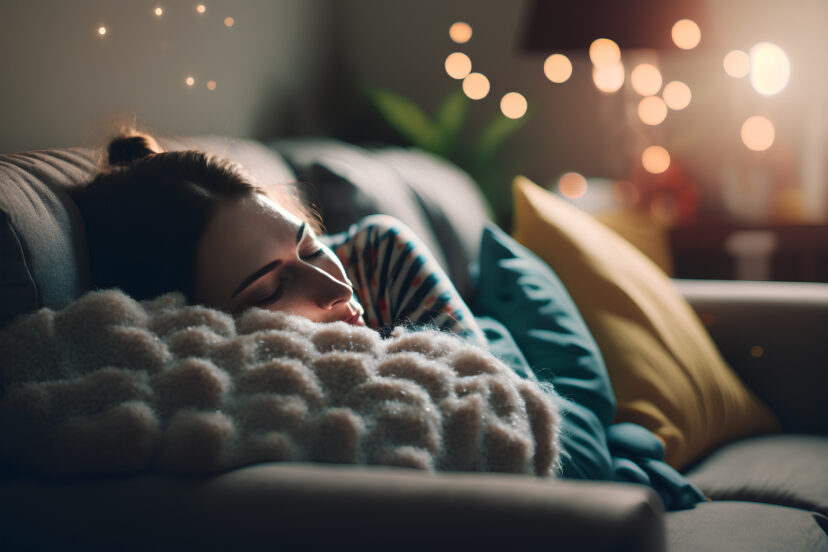Sleeping Sounds: Your Gateway to Restorative Slumber
In today’s fast-paced world, many individuals struggle with achieving a good night’s rest. Amidst this sleep crisis, the age-old method of using sounds to foster better sleep has been rediscovered. Sleeping sounds, ranging from the calming rhythm of ocean waves to the gentle hum of white noise, have gained significant attention as effective tools for enhancing sleep quality. These sounds, backed by both tradition and science, have paved the way for a new dimension in achieving restorative slumber.
Historical stories and records highlight the use of soothing sounds to induce sleep. These sounds not only hold a special place in our hearts but also connect us to our roots and ancestral practices.
Historical Connection to Soothing Noises
From the beginning of time, humans have always been surrounded by natural sounds. The gentle rustling of trees, the rhythmic patterns of rainfall, and the distant howls of animals were an integral part of the nightly backdrop. These ambient noises, apart from being constant factors, played a pivotal role in determining safe environments. Places with a balanced cacophony of these sounds were often deemed safe, while sudden disturbances or a stark silence could indicate potential dangers.
Ancestral Significance
Our ancestors didn’t have the luxuries of modern-day sound machines or apps, but they were well-acquainted with the soothing potential of natural sounds. They inherently understood that consistent, gentle sounds, like the flow of water or chirping of nocturnal insects, signaled a peaceful environment, devoid of threats. This not only made it easier to fall asleep but also ensured a deeper, more restful slumber. This relationship between man and nature, especially the sounds, was almost therapeutic, setting the stage for what we know today as sleeping sounds.
Evolution of Sound Machines
With the rapid progression of technology and urbanization, natural sleeping sounds began to fade, replaced by the jarring noises of bustling cities. This led to the evolution and creation of sound machines. These machines, designed to replicate natural sounds, aimed to restore the lost connection between humans and the therapeutic sounds of nature. From reproducing the delicate sounds of a forest at dusk to mimicking the constant noise of a waterfall, sound machines have come a long way in ensuring that quality sleep isn’t compromised, even in the noisiest of environments.
Understanding the Impact of Sleeping Sounds
Incorporating sleeping sounds into one’s nightly routine isn’t just a matter of preference; it’s backed by science. The continuous, soothing sounds help mask sudden disturbances, making it easier to fall and stay asleep.
The Science Behind the Sounds
The brain, in its resting state, is more aware of sudden, intermittent noises. These unexpected noises can jar one out of sleep or prevent one from falling asleep in the first place. Here’s where sleeping sounds come into play. By providing a constant auditory background, they ensure that these sudden noises are less jarring, allowing the brain to remain in a restful state. Essentially, sleeping sounds act as a buffer, smoothing out the auditory experience, and promoting uninterrupted sleep.
Psychological Effects
Beyond the scientific reasoning, sleeping sounds also have profound psychological effects. They act as anchors, creating a familiar and safe auditory environment. This sense of familiarity and safety is crucial, especially in unfamiliar settings, like a new home or while traveling. The consistent backdrop of sounds provides comfort, signaling to the brain that the environment is secure. Additionally, certain sounds can evoke pleasant memories or feelings, acting as auditory therapy. For instance, the sound of ocean waves might remind one of a cherished beach vacation, further enhancing the relaxation process.
Popular Sleep Sounds & Their Effects
The world of sleep sounds is vast, with each sound having its unique characteristics and effects on the human psyche and body. From sounds that remind us of nature’s grandeur to those that transport us to different parts of the world, let’s delve into the most popular sleep sounds and understand their effects.
1. White Noise
White noise is a consistent sound that plays across all hearable frequencies. It’s known for its effectiveness in drowning out other noises, which makes it especially beneficial in noisy environments. Its even keel and lack of distinguishable features make it a perfect backdrop for those who need a consistent sound to drift off.
Effect: The uniform nature of white noise can mask sudden disturbances, offering an uninterrupted sleep environment. It’s particularly useful for light sleepers or those living in busy urban settings.
2. Ocean Waves
The rhythmic crashing of ocean waves against the shore offers a calming auditory experience. It’s repetitive yet natural, providing a serene backdrop.
Effect: The ebb and flow of waves can mimic the rhythm of breathing, promoting relaxation. It can also evoke memories of vacations or peaceful moments by the beach.
3. Rainfall
The pitter-patter of raindrops on rooftops or against windows is a favorite for many. Whether it’s a gentle drizzle or a heavy downpour, the sound of rain can be incredibly soothing.
Effect: Rain sounds can create a cocoon-like feeling, making one feel safe and snug. It’s also known to reduce stress and anxiety, promoting deeper relaxation.
4. Forest Ambience
This sound includes distant bird calls, rustling leaves, and sometimes even the distant sound of water, offering a complete immersive experience of being in a forest.
Effect: Nature sounds, especially those from forests, are known to reduce cortisol levels (the stress hormone) and increase feelings of relaxation and calm.
5. Babbling Brook
The gentle sounds of a stream or brook, with its soft gurgles and flow, can be a peaceful sound to sleep to.
Effect: Much like ocean waves, the repetitive yet gentle sound of flowing water can be hypnotic. It’s also associated with cleanliness and freshness, often promoting feelings of rejuvenation.
6. Thunderstorms
While it might seem counterintuitive, many find the distant rumble of thunder combined with rainfall very calming.
Effect: The contrast between the cozy indoors and the storm outside can amplify feelings of safety and warmth, enhancing the sleep environment.
7. Crickets Chirping
A nighttime symphony, the sound of crickets chirping, is a gentle reminder of warm summer nights.
Effect: Crickets’ rhythmic chirping can act as a lullaby for some, with its consistent yet gentle tone offering a peaceful backdrop for sleep.
8. Wind Chimes
Gently clinking wind chimes, especially bamboo ones, evoke a sense of peace. The soft, random melodies created by a breeze can be very meditative.
Effect: The unpredictability of the chime tones can engage the mind just enough to distract from stressful thoughts and lead to relaxation.
9. Heartbeat
The rhythmic beat of a heart can be deeply soothing, especially for newborns, as it mimics the sound they heard in the womb.
Effect: It provides a sense of security and comfort, helping to stabilize the heart rate of the listener and promote deep sleep.
10. Campfire
The crackling of wood and the occasional pops from a campfire recreate nights under the stars, surrounded by nature.
Effect: The sound of a campfire can create a warm, cozy atmosphere, driving away the cold and lulling the listener into a state of relaxation.
11. Train Journey
The rhythmic clatter of a train on tracks, combined with the distant sounds of passing landscapes, can be both mesmerizing and comforting.
Effect: This sound can be reminiscent of long journeys and adventures, making the listener feel as if they’re being rocked gently to sleep.
12. Clock Ticking
While it might be annoying for some, others find the consistent ticking of a clock very soothing.
Effect: The regularity of the tick-tock can help regulate breathing patterns and lull the listener into a meditative state.
13. Cat Purring
The soft, rhythmic purring of a cat is not just comforting for the feline but also for humans around them.
Effect: A cat’s purr can evoke feelings of warmth, safety, and companionship, making it easier to drift into sleep.
14. Tibetan Singing Bowls
These ancient instruments produce resonating sounds that many find deeply calming and spiritual.
Effect: Their rich overtones can induce deep states of relaxation and meditation, aiding in sleep onset and quality.
15. Gentle Acoustic Guitar
Soft melodies played on an acoustic guitar can be a peaceful auditory experience, transporting listeners to moments of calm and introspection.
Effect: Music, especially when played on instruments like the guitar, can reduce anxiety levels and create a serene sleep environment.
Incorporating these sounds into one’s sleep routine can aid in faster sleep onset and improved sleep quality. However, it’s essential to remember that everyone is unique. What works for one might not work for another. It’s always a good idea to experiment and find the sound that’s just right for you.
Benefits of Using Sleep Sounds
The ambiance created by sleep sounds has been lauded for centuries. But why is it that these sounds have such a pronounced effect on our sleep quality and overall well-being?
- Improved Sleep Quality: Sleep sounds mask background noises, ensuring that the brain doesn’t need to process them. This can be especially useful in urban settings where ambient noises can disrupt our sleep cycle. By masking these disruptions, sleep sounds create a consistent environment, leading to deeper, more restful sleep. Research has shown that individuals who listen to soothing sounds at bedtime often experience longer periods of deep, REM sleep, which is vital for cognitive function and memory.
- Stress Reduction: There’s a reason why so many meditation and mindfulness apps utilize calming nature sounds. The auditory sensory experience can shift our focus from stressful thoughts, grounding us in the present moment. This ‘sound therapy’ lowers cortisol levels, the primary stress hormone, leading to a more restful slumber.
- Mental Calmness: Listening to certain sounds, especially those from nature, can stir feelings of nostalgia or connection to the larger world around us. This form of soundscapes can redirect racing thoughts, promoting a sense of tranquillity. Many individuals report that sleep sounds help clear their minds, making the transition into sleep more seamless.
Incorporating Sounds into Your Nightly Routine
Making sleep sounds a part of your nightly ritual can be quite straightforward, thanks to modern technology.
- Sound Machines: Dedicated devices designed to produce ambient sounds can be a worthy investment for those serious about their sleep health. Many come with a range of sounds, from ocean waves to forest nights, and can operate on a timer to save energy.
- Mobile Applications: Numerous apps are available that offer a wide array of sleep sounds. These are especially handy as they’re portable, and many are free. Some even allow you to mix and match sounds, creating a personalized sleep soundscape.
Cautions & Considerations
As beneficial as sleep sounds can be, it’s essential to use them wisely.
- Volume Control: The sounds shouldn’t be so loud that they could damage your hearing or disturb others. A moderate volume that masks external noises but isn’t overwhelming is ideal.
- Frequency & Duration: While it might be tempting to play your favorite sleep sound every night, it’s beneficial to change things up now and then to prevent dependence. Also, using a timer ensures that the sound doesn’t play all night, which might be disruptive for some.
Debunking Sleep Sound Myths
Misconceptions abound regarding sleep sounds. Some believe they can cure insomnia – while they can help, they aren’t a replacement for professional medical advice. Others think that any noise is disruptive to sleep, but the consistency and type of sound are the key factors. It’s crucial to remember that everyone’s experience with sleep sounds will be subjective; what works wonders for one person might not for another.




